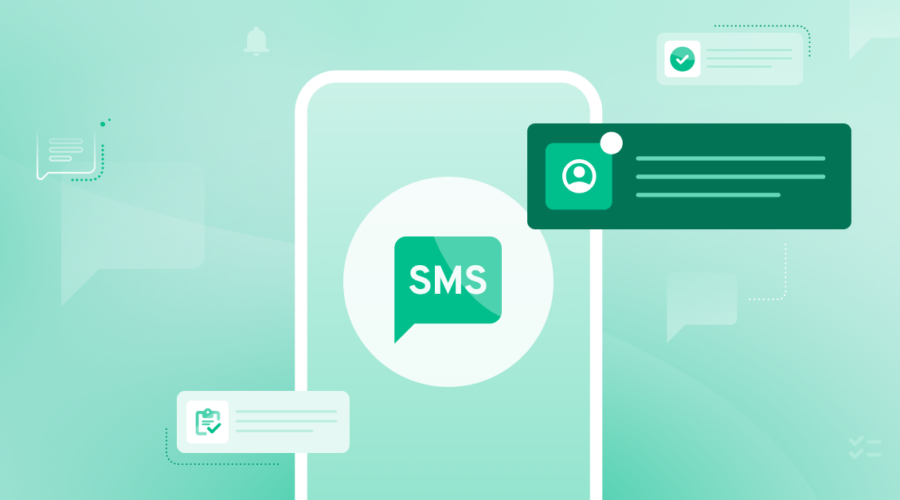Global businesses have come to love Microsoft Teams for its cloud-based unified communications tools, telephony control, and app ecosystem.
But while Microsoft Teams may have stolen the enterprise IT leader’s heart, texting is still the communications sweetheart for employees and consumers alike.
Can you send texts from Microsoft Teams?
Microsoft Teams doesn’t offer built-in texting features that allow users to send and receive messages with customers. Instead, you can add third-party tools to your unified communications stack to send and receive SMS and MMS.
These apps should be off-the-shelf and easy to install, so your employees don’t have to waste any time in that awkward ‘get-to-know-you’ phase.
Here’s how to add and use a messaging app in Microsoft Teams.
How to add messaging to Microsoft Teams with Send-to
To follow along with this tutorial, you’ll need three things: A Microsoft 365 license, a UCaaS Integration for Microsoft Teams, via Direct Routing or Operator Connect, and the Send-to messaging app.
There are five major steps when integrating an SMS/MMS app into Microsoft Teams:
- Picking the messaging app
- Setting up Azure Active Directory
- Downloading and configuring the messaging app
- Installing the messaging app
- Sending texts and creating contacts
Step 1: Pick your texting app
- Can use your existing phone numbers
- Sends and receives chats from Microsoft Teams channels
- Doesn’t store personal information, messages, or media
- Works directly within Microsoft Teams
- Accepts both SMS and MMS message types
- Doesn’t require development work and includes self-service instructions
Our job is to help you pick the right one for your business objectives, security requirements, and user experience.
All of these might not be important to your organization, so make sure you understand what your priorities and requirements are as you’re shopping around. In addition, not all messaging apps are available in Microsoft’s AppSource, so make sure you do your due diligence before committing to a solution that doesn’t meet all of your needs.
Read the 2024 Enterprise Communications Landscape
Hear how 1,000 IT leaders are improving their employee experiences.

Step 2: Set up your Azure active directory
Some apps make you create an Active Directory user with Microsoft Outlook licensing on the Teams tenant to store the messaging bot’s contacts.
Add a user to use the Send-to license
Before you begin, navigate to the Microsoft Azure active directory and select Add > User. Then, create a new user for the Send-to messaging bot with default settings.

Once completed, select the Send-to user from the list of Users and select Licenses. Then, select Assignments and choose a license that supports Microsoft Outlook.
Step 3: Download and configure the messaging app
Once you’ve landed on the messaging app for you, it’s time to set it up! If you’ve selected a messaging solution that works out of the box, this step should be short and sweet.
To download and deploy a third-party texting application within Microsoft Teams, you should:
Create the messaging app within Microsoft Teams
To do this, log into the Bandwidth dashboard and select the account you’re creating the messaging application in. Make sure you update all records according to the installation guide.

Create a location and user
Your phone numbers will exist under this location, and this user will establish the rights and permissions to allow the Send-to application to work with your Bandwidth account.
Order your phone numbers
From the Bandwidth dashboard, you can select different area codes for your messaging phone numbers. Select purchase, and confirm your order status is complete.

Step 4: Install the messaging app
First, add Send-to to the organization’s inventory of applications available for individual teams by uploading the manifest.zip file in the Microsoft Teams admin portal. Make sure you grant permissions to the Send-to app:

Next, install the application for specific channels. To do this, you must be a Teams administrator or admin for the specific team.
Step 5: Start texting!
You’ve added your messaging app to Microsoft Teams, picked your numbers, and configured your settings—it’s time to start texting! As you’re using Send-to, there are a few different actions you can perform.
Launch the messaging app from a channel
Type @send-to. The moment you start typing, Microsoft Teams will auto-complete for you. Then, select New Text Message.

Create your text and attach media
Enter a number, type out your message, and add multimedia attachments.

Manage your contacts
After you hit send, you can create and edit each contact.

Reply to texts
Respond to customer communications directly from each text.

Share texts across channels
Share messages across your team for visibility and collaboration.

If you’ve made it this far, congrats—you’re done! Thanks for sticking around, and we hope you find this app helpful in your day-to-day work.
Get started with 2-way texting in Microsoft Teams
Texting from Microsoft Teams instead of an external app can bring your employees faster response times, quicker collaboration, and less to manage for IT teams.
To learn more about how to bring texting to your Microsoft Teams tenant with Bandwidth, check out the following resources:





